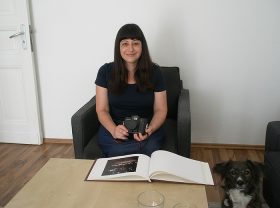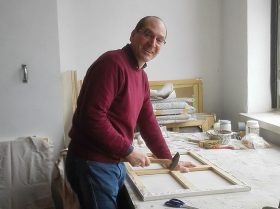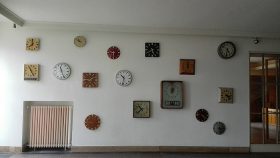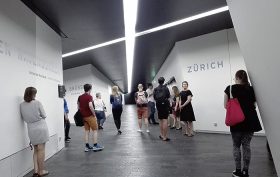An Encounter with Daniela Orvin, Photographer

Daniela Orvin in her studio apartment in Berlin in June 2016: in her hand, a plastic camera, her Holga; in the foreground, her photo book Dressur-Wunder; below right her dog, Laika; Jewish Museum Berlin, photo: Maren Krüger
“Dyslexic dysgraphia”—the title of the photo series by Israeli artist Daniela Orvin on sale since April 2016 in the Jewish Museum Berlin’s art vending machine is pretty difficult to grasp; but it simply means “difficulty with reading and writing.” “Every one of my artworks is a self-portrait,” the photographer and musician told me, when I paid her a visit one sunny afternoon at her studio apartment in Berlin-Friedrichshain. She herself has difficulty reading but she was 29 years old before the handicap was detected—despite it having caused considerable disorientation her whole life long. Place the photos in the “Dyslexic dysgraphia” series side by side and they resemble the symbols of some bizarre, outlandish language. → continue reading
Joachim Seinfeld’s HeimatReisen (HomelandTravels)

Joachim Seinfeld at work in his atelier in the former broadcasting station in Berlin; Jewish Museum Berlin, photo: Michaela Roßberg
The wonderful thing about Berlin for me as an historian is that there’s something around every corner waiting to wow me or get my “history heart” to skip a beat. I was able to get to know yet another spot this year when I interviewed Joachim Seinfeld in his atelier in the old broadcasting station in the Berlin Treptow-Köpenick district. We talked about his HeimatReisen (HomelandTravels) project for the art vending machine at the Jewish Museum Berlin (further information on the art vending machine on our website).

The station’s entryway was built with marble tiles from the New Reich Chancellery; Jewish Museum Berlin, photo: Michaela Roßberg
The broadcasting station on Nalepastrasse is a unique place: Beginning in 1956, programming across the former GDR was produced and broadcast from there. The public broadcasting system, established following German reunification, took over this work in 1991 and then, after several changes in ownership, the building became a place for artists from around the world to establish their ateliers.
Joachim, your photo series – available to visitors in the art vending machine – consists of a number of images depicting you in various locations around Germany. Why, of all your work, these images for the vending machine?
In 2006, I did a photo series about Poland. In 2011, I thought to do something similar about Germany. So I wanted to do it anyway, and I chose the images most interesting to me. → continue reading
An Architectural Instawalk through the Jewish Museum Berlin

Instagrammers in the Libeskind Building; Jewish Museum Berlin, photo: Judith Westphal
Where might one best spend the hottest day of the year? If not on the water or in the woods, there are only a few reasonable options. For example, an air conditioned museum with lots of underground passages! Fitting then that as part of Architecture Day on Friday, June 24th 2016, we led a very special kind of museum tour: Equipped with smartphones and professional cameras, we took a group of Berliner Instagrammers through the labyrinth that is the Libeskind Building, with Tommaso as guide. Even we as staff were able to learn a thing or two. → continue reading



